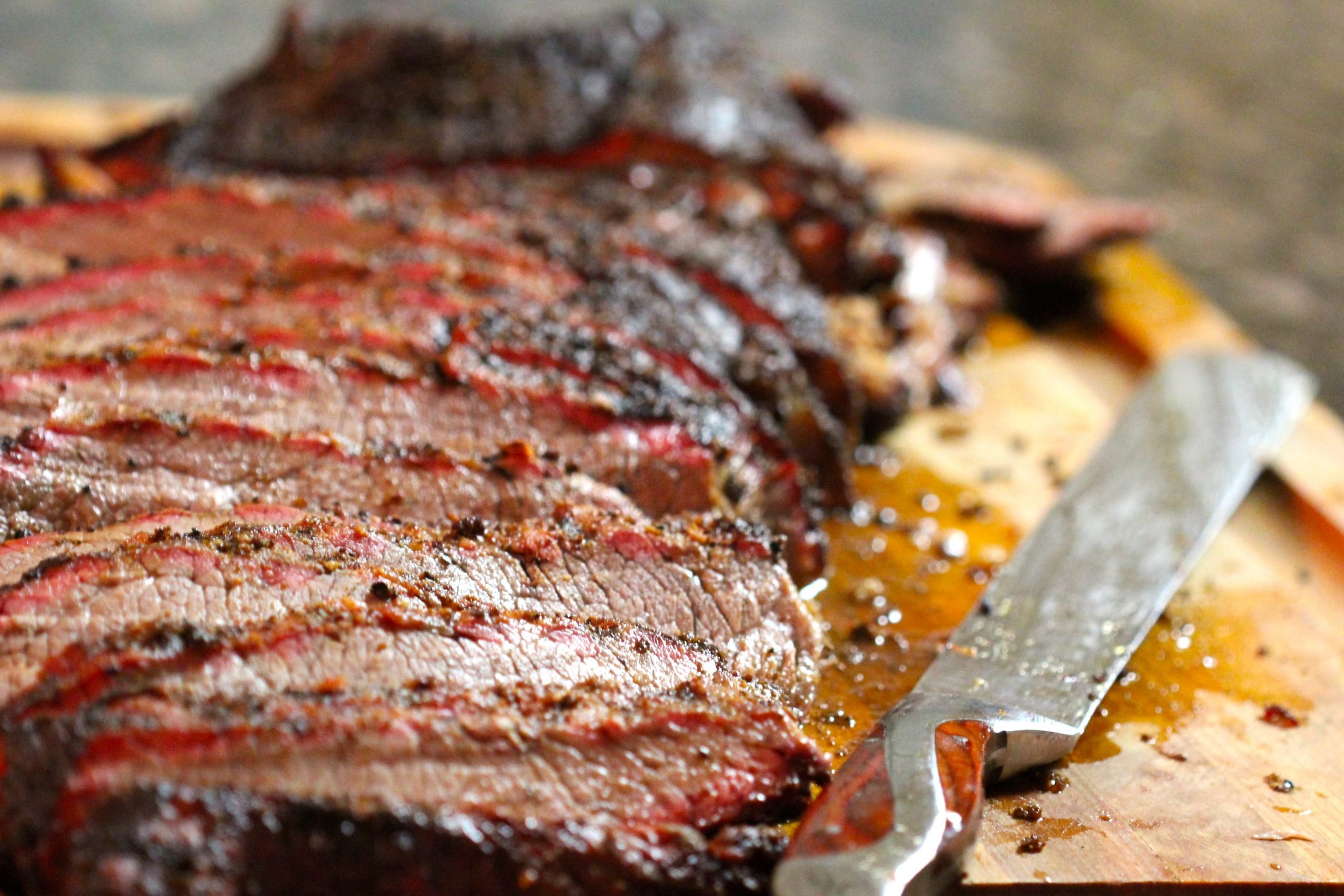If you love BBQ beef brisket but have always been intimidated by the thought of smoking one yourself at home then this is the perfect "how to" recipe to help you get it done to perfection.
Serve with: your favorite pale ale or IPA.
Makes:
1 killer brisketServings: (approximately 1 pound (454 g) starting weight per person)
Takes:
Equipment
- 4 cups wood chunks or chips (about 8 ounces (226 g))
Ingredients
Brisket
- 12 pound beef brisket whole packer (point and flat together) untrimmed, USDA Choice grade or higher
- 12 ounces beef broth (approximately 1 ounce per pound of meat)
- 6 teaspoons Morton Coarse Kosher Salt (approximately ½ teaspoon per pound)
- ½ cup Big Bad Beef Rub (alternatively, you can use our bottled commercial beef rub)
Texas Crutch
- ½ cup beef broth
Notes:
About the Big Bad Beef Rub. If you’d rather not make this rub from scratch you can buy it instead. We have created a bottled rub that is very similar and you can purchase it here. Keep in mind that our bottled rubs have salt in them. When using the bottled rub with this recipe, you do not need to add the salt that is called for in the recipe. Just use the rub instead and add it when the salt is called for.
About the salt. Remember, kosher salt is half the concentration of table salt so if you use table salt, use half as much. Click here to read more about salt and how it works.
About the brisket. I cannot stress this enough: When shopping for brisket, go for the highest grade you can find, and hand pick the slab with the most fat striation visible. Pay no attention to the fat cap. You will trim most of that away. But marbling is important. Go for USDA Choice, USDA Prime, or Certified Angus Beef. If it is not labeled, chances are it is USDA Select. Avoid it. Brisket is the classic example of "garbage in, garbage out." Please don't write to me and say you can't figure out why your brisket was tough if you did not buy USDA Choice or better.
Beware. Corned beef is brisket that has been corned, which means it has been preserved with salt and flavorings. It is not suitable for this recipe! To make Texas brisket, you need raw beef. However, if you love corned beef, click here for a recipe showing you how to make your own corned beef, or click here to make corned beef hash, here for corned beef and cabbage, here for an amazing recipe for smoking corned beef to make pastrami, or here to see how to make Rockin' Reuben pastrami sandwiches.
Sauce, optional. 2 cups Texas Barbecue Mop Sauce (you can make this days in advance) for a packer.
Metric conversion:
These recipes were created in US Customary measurements and the conversion to metric is being done by calculations. They should be accurate, but it is possible there could be an error. If you find one, please let us know in the comments at the bottom of the page
Method
- Trim. Trim off most of the fat cap but leave about 1/4" (6.3 mm). Until you get the hang of trimming fat, you might cut off some of the meat in the process. No harm, no foul. Some cooks attempt to remove some of the fat layer between the flat and the point by slicing them apart from both sides, but not slicing all the way through so they remain attached. Go for it, if you like. Either way, when you're done trimming fat, clean the meaty side of any silverskin, a shiny, thin, tough membrane. Set aside some fat for making burnt ends, described below. I always freeze some of the fat and grind it for my burgers if I think the meat needs more fat. I also render some fat over low heat in a pan, and freeze that too. I use beef fat to paint my steaks just before searing.
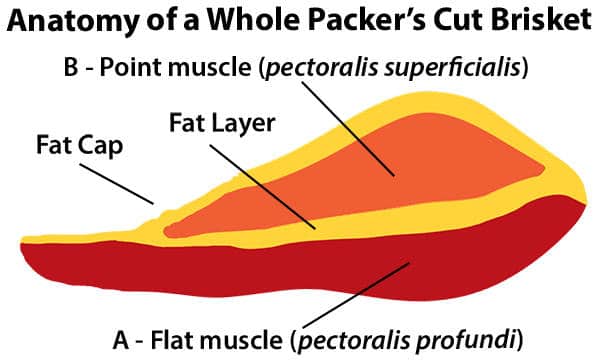
- Separate. You can remove the point at this stage, especially if you want to turn it into those luscious chunks of beef candy called burnt ends. Purists cry heresy, but separating the point and flat gives you a flat that is pretty uniform in thickness so it will cook more evenly. Plus, you can apply flavorful rub to all sides of the flat, and you will get an all-around smoke ring. You can cook the point and flat side by side.
- Inject (optional). I almost always inject briskets with beef broth. This meat takes so long to cook that the extra moisture helps keep it from dehydrating, and the salt helps the meat hold onto moisture and enhances flavor. Use broth only. No need to add spices, juices or other flavorings. All we want here is moisture. We don't want the fluid to mask the flavor of the meat. If you have a hypodermic syringe for injecting meat, now's the time to use it. Pump in about 1 ounce (28 g) of beef broth per pound of raw meat by inserting the needle parallel to the grain in several locations about 1" (2.5 cm) apart and backing it out as you press the plunger. Do it in the sink, and be careful so you don't get squirted in the eye.
- Season. If you have not injected salt, salt the meat about 12 to 24 hours in advance so it can work its way in, 2 to 4 hours minimum. If you have injected a salt solution, do not salt the meat.Notice the direction of the grain of the flat and remember this so you can carve the cooked brisket perpendicular to the grain. The grain will be hard to find under the bark when it is done, so some people mark it with a slice in the surface or cut off a slice to show them the way to cut later. After salting, sprinkle the Big Bad Beef Rub liberally on all areas of the meat and rub it in. Keep the meat chilled until just before you cook it. Chilled meat attracts more smoke. I strongly recommend you use a remote digital thermometer and insert the probe with the tip centered in the thickest part of the meat furthest from the heat.
- Fire up. Pre-heat your smoker, or if you are using a grill, set it up for indirect cooking. Click here to see how to set up a gas grill, here to set up a charcoal grill, or here to set up a bullet smoker like the Weber Smokey Mountain. Get the cooker temp stabilized at about 235°F (113°C). We want to cook at about 225°F (107°C), but the temp will drop a bit once you open the lid and load in the cold meat.
- Cook. Put the meat on the cooker. On a smoker with a water pan, put the meat right above the water. Place the oven temp probe on the grate next to the meat. Add about 2 cups (4 ounces (113 g)) of wood right after the meat goes on. When the smoke stops, add 4 ounces more during the first 2 hours, which usually means adding some every 30 minutes or so. Keep an eye on the water in the pan. Don't let it dry out. After 3 hours, turn the meat over if the color is different from top to bottom. Otherwise, leave the meat alone. No need to mop, baste, or spritz. It just lowers the temp of the meat and softens the bark.
- Wrap (optional). The meat's internal temperature will move steadily upward to somewhere around 150 to 170°F (55 to 77°C), and then it will enter the stall. Once in the stall, the temp will seem to take forever to rise. The stall can last 5 hours and the temp may not rise more than 5°F! When the meat hits the stall and temp stops rising, take it off and wrap it tightly in a double layer of heavy-duty foil. We have learned that the more airspace around the meat, the more juice leaks out of the meat. Crimp it tight and put the wrapped meat back on the smoker or move it to an indoor oven at 225°F (107°C). This step, called the Texas Crutch, slightly braises and steams the meat, but most importantly, it prevents the surface evaporation that cools down the meat and causes the stall. If you wrap the meat at 150°F (65°C), it will power right through the stall and cut your cooking time significantly.
- Burnt ends (optional). Burnt ends are amazingly flavorful bite-size crispy meat cubes. Originally they were simply edges and ends that were overcooked and trimmed off and munched by the kitchen staff. If there were any leftover, they were given away for free. Then, in 1970, in his marvelous book American Fried, Calvin Trillin wrote the following about Arthur Bryant's restaurant in Kansas City "The main course at Bryant's, as far as I'm concerned, is something that is given away for free -- the burned edges of the brisket. The counterman just pushes them over to the side as he slices the beef, and anyone who wants them helps himself. I dream of those burned edges. Sometimes, when I'm in some awful overpriced restaurant in some strange town -- all of my restaurant-finding techniques having failed, so that I'm left to choke down something that costs seven dollars and tastes like a medium-rare sponge -- a blank look comes over my face: I have just realized that at that very moment someone in Kansas City is being given those burned edges free."

- Temp it. When the meat temp hits 195°F (95°C), start poking it. Poke it with a thermometer probe. It should slide in and out with little resistance if it is done. Poke it with a finger or pick it up and jiggle it. If it goes wubba wubba and wiggles like jelly, it is done. This usually happens somewhere between 195 and 205°F (90 and 96°C), usually at around 203°F (95°C).
- Cheating. Here's my technique, strictly illegal in BBQ competitions, but very welcome in my family. In a frying pan, render about 1/4 pound of the beef fat that you trimmed from the brisket. Or cheat and use bacon fat or duck fat. You can do this over hot coals. Cut the brisket point into 1/2" to 3/4" (12 to 19 mm) cubes. Set aside any pieces that are too fatty or just eat them. Put the cubes in the pan and gently fry the cubes until they are crunchy on the outside, turning them a few times. Drain the fat and add about 1/4 cup (60 ml) of your favorite BBQ sauce and 1/4 cup (60 ml) of the drippings from the foil used for the Texas Crutch. Put the pan back on the cooker in a hot spot and close the lid. Stir every 5 minutes or so. Let the cubes absorb most of the liquid and start to sizzle, but don't let them burn. When they're done, keep them warm in the faux cambro with the flat.
- Faux Cambro. Cambros are insulated boxes used to keep food warm for extended periods of time. To create a home made version, get a plastic beer cooler, line it with a towel, blanket, or crumpled newspaper, and put the meat, still in foil, into the cooler on top of the lining. If the foil is leaking fluids put the meat in a large pan first. Leave the thermometer probe in the meat. Close the lid and let the hot meat sit in the cooler for 1 to 4 hours until you are ready to eat. If you can, wait til it drops to 150°F (65°C) to slice it. If you have a tight cooler, it should hold the meat well above a safe serving temp of 140°F (60°C) for several hours. Click here for our cooler reviews.
- Slice (How do I slice brisket?). Don't slice until the last possible minute. Brisket dries out very very quickly once it is cut. If you wish, you can firm up the crust a bit by unwrapping the meat and putting it over a hot grill or under a broiler for a few minutes on each side. Watch it closely so it doesn't burn. Sauce should not be needed if the brisket is juicy, but if you want sauce, just don't use a sweet one. Heat up my Texas Barbecue Mop Sauce or heat up the jus in the foil and bring it to the table. Beware: Taste the jus first. It might be salty. You can dilute it warm water or unsalted beef broth. Important: Turn the meat fat side up so the juices will run onto the meat as you slice.
- Slicing is a bit of a challenge because there are two muscles (the point and the flat) and the grain flows in different directions. In this photo you can see the grain in the meat. The point muscle sits on top of the flat muscle. The point is thin on one end (A) and thick on the other (B). The thickness of the slab varies significantly, from 1" (2 cm) at the left and right edge to 4" (10 cm) or more at the crown of the point.Here are three methods for carving. (I) the easy method, (II) the Sorkin method, and (III) the competition method.

- (I) The easy methodLop off about 1" (2 cm) from the thick end and about 2" (5 cm) from the thin end, which is the tip of the flat. These ends are likely overcooked and dry. Chop them and smother them in sauce for chopped brisket. Then find the fat layer between the point and flat and slide your blade between the two muscles. Separate them, and trim off most of the excess fat. Find the grain of the flat and slice across the grain. You can also slice against the grain of the point. Offer your guests "lean" or "fatty." Most will choose the lean, which will leave the better, fattier, point cut for you (turn it into burnt ends!).
- (II) The Sorkin slicing methodI learned this method from Barry Sorkin of Chicago's Smoque BBQ. He makes my favorite brisket in the world. In the photos below, Sorkin demonstrates how he slices a whole packer brisket.
- Start by removing the drier thin part of the flat, and set it aside for chopping, not slicing.
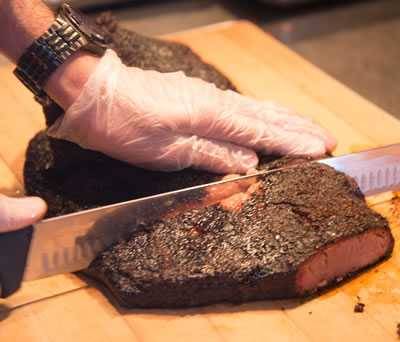
- Then slice the thick center part of the flat across the grain until you encounter the point muscle on top of the flat. In the photo above, he is within one or two slices from hitting the point. These center cut slices are the ones that most competitors use because they produce a visually pleasing presentation of nearly identical slabs of meat.
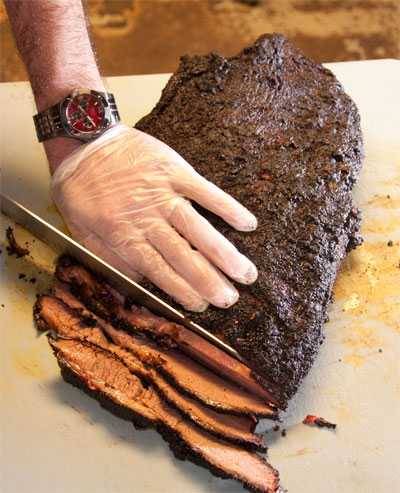
- Sorkin then goes into the layer of fat between the point and flat at the thick butt end, and he removes much of the fat. It can be 1/2" (13 mm) thick or more in there, and that makes the slices inedible.
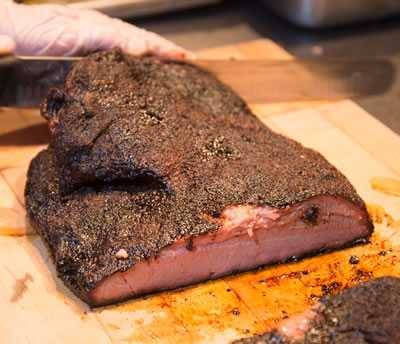
- The remaining hunk has both muscles, the point sitting on top of the flat, with the grain going in different directions. He slices this hunk in half.

- Here, the section on the right is a butt end with one cut edge. The left section, from the center the brisket, has two cut edges.
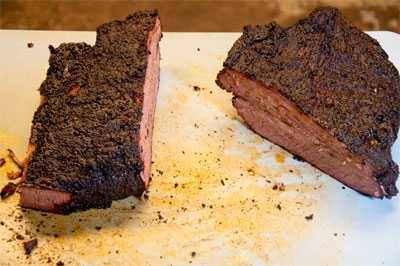
- Slice the center section as shown, from the outer edge in.

- Slice the remaining butt end of the point in the same direction as you cut the flat, continuing to cut parallel to the cut end.
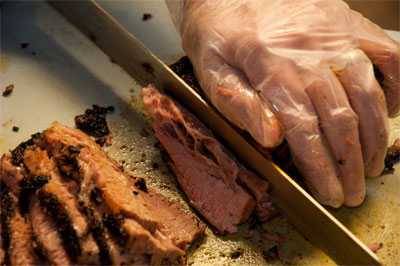
- Sorkin then fans the slices on a bun. Notice the line separating flat and point.
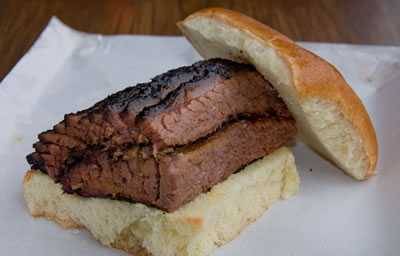
- Thin parts of the flat are chopped and some of the fat from between the point and flat is mixed in for moisture. The results are crunchy, heavily seasoned, and juicy. These bits can also be splashed with sauce and served on a bun.
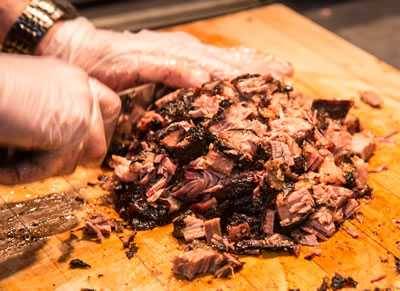
- (III) Competition brisket slicing methodSome competitors prefer this method of slicing. Run a knife between the flat and the point and separate the two muscles. Trim off excess fat. Slice each muscle separately across the grain about 1/4" (6.3 mm) thick. The meat should hold together, not fall apart or crumble. It should only pull apart with a gentle tug. If the first slice falls apart, cut thicker slices. Here is a picture of a competition brisket entry by Kansas City Barbecue Society (KCBS) President Emeritus Candy Weaver. Notice the nice even slices of flat with the smoke ring on top surrounded by chunks of burnt ends. Learn more about how to cook competition brisket here.
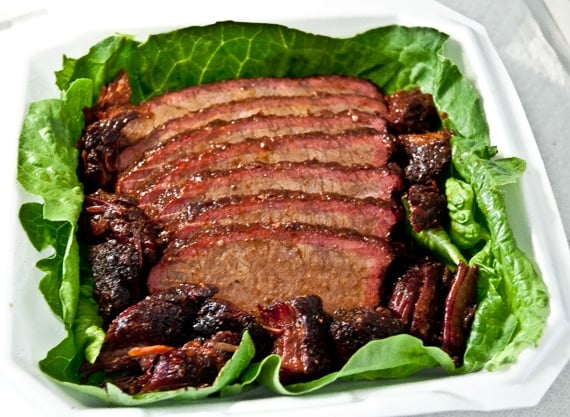
- Serve. If the brisket is perfectly cooked, it should be moist and juicy. You can serve it simply sliced on a plate or as a sandwich made with Texas Toast. If you wish, drizzle some Texas Barbecue Mop Sauce mixed with some of the drippings from the Texas crutch on top of the meat. Taste the drippings first because they can be salty (if so, you can dilute them with water or unsalted beef broth). Here's one of my faves: At Joe's KC in Kansas City the serve a sandwich called the "Z-Man". It's thin sliced brisket with a sweet KC sauce topped with melted provolone cheese, a couple of thick crunchy onion rings, more sauce, all on a toasted kaiser roll, and slaw on the side. You want pickle chips on it, go ahead.
Nutrition per Serving
Calories: 705kcal | Protein: 95g | Fat: 33g | Saturated Fat: 12g | Cholesterol: 281mg | Sodium: 1591mg | Potassium: 1574mg | Calcium: 23mg | Iron: 9mg
